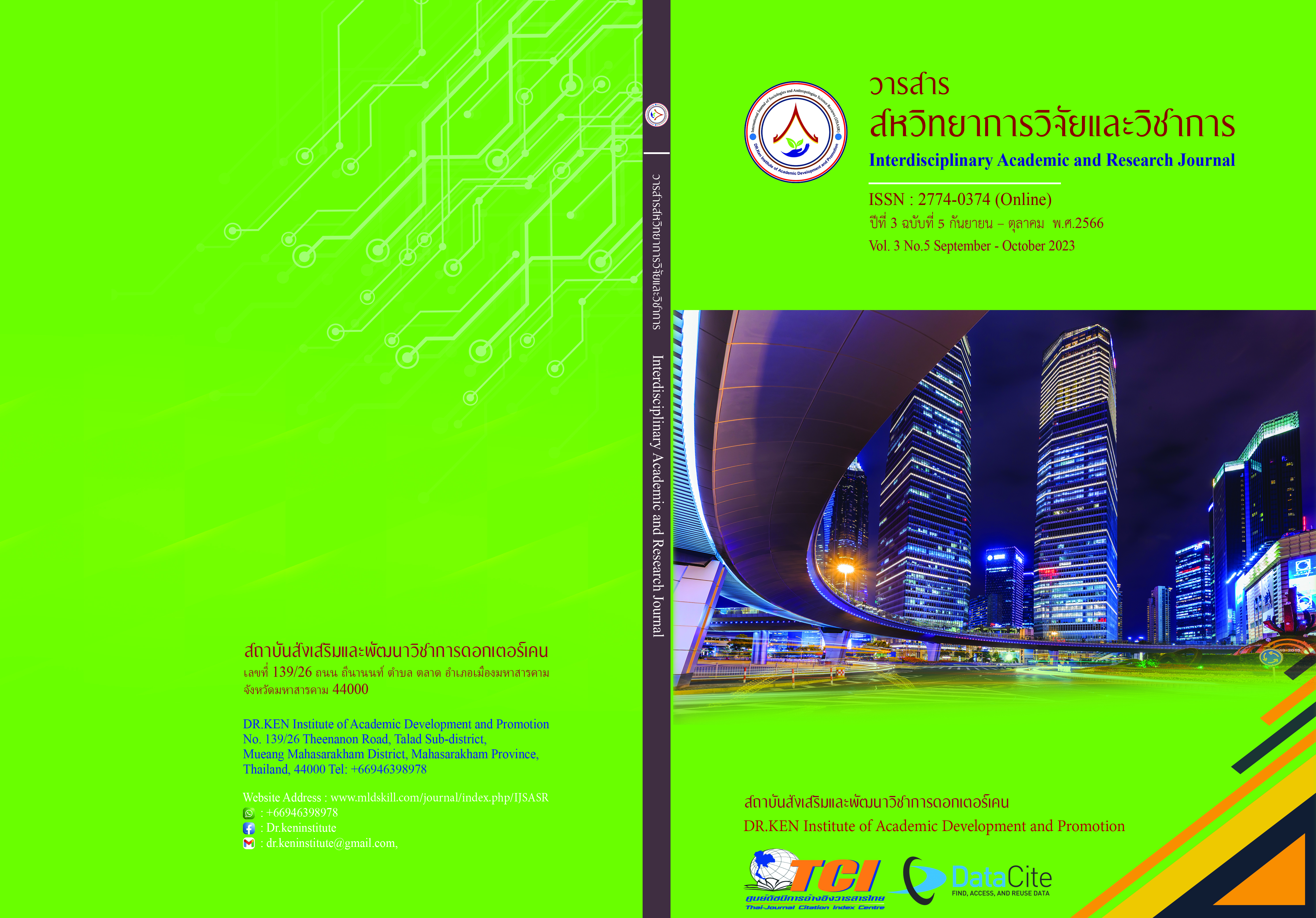STEM Education in Enhancing Creative Thinking and Attitudes Towards Science of Grade 7 Students
DOI:
https://doi.org/10.14456/iarj.2023.269Keywords:
STEM Education; , Creativity; , Learning Achievement;, Attitudes towards SciencesAbstract
The 21st century is an era of innovation and technology that has developed exponentially. Students must therefore be developed to achieve learning. Understand and be able to apply knowledge creatively Therefore, the purposes of this study were 1) to compare the creative thinking of grade 7 students between pre-test and post-test scores of STEM education on Thermal Energy, 2) to compare the learning achievement of grade 7 students between pre-test and post-test scores of STEM education on Thermal Energy and 3) to study attitudes towards sciences after the STEM education on Thermal energy. The sample group was 42 grade 7 students at Anukoolnaree School from cluster random sampling technique. The research instruments were 1) STEM lesson plans on thermal energy for 21 hours, 2) creative thinking, 3) learning achievement tests, and 4) attitudes towards sciences inventory. The data analysis statistics were mean, standard deviation, and Dependent-Samples t-test. The research revealed that 1) grade 7 students had creative thinking post-test average scores higher than the pre-test average score with a statistically significant difference at level 5, and 2) grade 7 students had learning achievement post-test average scores higher than the pre-test average score.
References
กระทรวงศึกษาธิการ. (2546). แนวทางการจัดกิจกรรมการเรียนรู้เพื่อพัฒนาทักษะการคิดวิเคราะห์. กรุงเทพฯ: สำนักวิชาการและมาตรฐานการศึกษาขั้นพื้นฐาน.
กระทรวงศึกษาธิการ. (2553). หลักสูตรแกนกลางการศึกษาขั้นพื้นฐาน พุทธศักราช 2551. พิมพ์ครั้งที่ 3. กรุงเทพฯ: ชุมนุมสหกรณ์การเกษตรแห่งประเทศไทยจำกัด.
จุฑาภรณ์ มาสันเทียะ.(2562). การพัฒนาแบบวัดเจตคติของนักเรียนที่มีต่อการเรียนวิชาวิทยาศาสตร์สำหรับผู้เรียนระดับมัธยมศึกษาตอนต้น. วารสารสุทธิปริทัศน์, 33(108), 39-50.
ทิพธัญญา ดวงศรี. (2560). การจัดกิจกรรมการเรียนรู้แบบสะเต็มศึกษาเพื่อพัฒนาผลสัมฤทธิ์ทางการเรียนและ เจตคติต่อวิทยาศาสตร์ของนักเรียนในรายวิชาเคมี เรื่อง อัตราการเกิดปฏิกิริยาเคมีชั้นมัธยมศึกษาปีที่ 5. วิทยานิพนธ์ปริญญามหาบัณฑิต : มหาวิทยาลัยราชภัฏมหาสารคาม
ปรียา โคตรสาลี. (2562). การพัฒนาความคิดสร้างสรรค์ของนักเรียนชั้นประถมศึกษาปีที่ 6 เรื่อง สารในชีวิตประจำวัน โดยใช้การจัดการเรียนรู้แบบสะเต็มศึกษาร่วมกับผังกราฟิก. วิทยานิพนธ์ปริญญามหาบัณฑิต: มหาวิทยาลัยราชภัฏสกลนคร.
ปัญจนาฏ วรวัฒนชัย. (2563). การจัดบรรยากาศชั้นเรียนเพื่อพัฒนาความคิดสร้างสรรค์. วารสารครุศาสตร์สาร, 14(1), 271-294.
พลศักดิ์ แสงพรมศรี. (2558). การเปรียบเทียบผลสัมฤทธิ์ทางการเรียน ทักษะกระบวนการทางวิทยาศาสตร์ขั้นบูรณาการ และเจตคติต่อการเรียนวิชาเคมี ของนักเรียนชั้นมัธยมศึกษาปีที่ 5 ที่ได้รับการจัดการเรียนรู้สะเต็มศึกษากับแบบปกติ. วารสารศึกษาศาสตร์ มหาวิทยาลัยมหาสารคาม. 9(ฉบับพิเศษ), 410-411.
พันธ์ ทองชุมนุม. 2547. การสอนวิทยาศาสตร์ระดับประถมศึกษา. กรุงเทพฯ: โอเดียนสโตร์.
ภัทราวดี เอี่ยมพงษ์ และทนิตตา ชัยโชติ. (2564). การพัฒนาผลสัมฤทธิ์ทางการเรียนและความสามารถในการสร้างแบบจำลองรายวิชาวิทยาศาสตร์เรื่องแสงโดยใช้การจัดการเรียนรู้แบบผสมผสานตามแนวทางสะเต็มศึกษาของนักเรียนชั้นมัธยมศึกษาปีที่ 3/3 วิทยาลัยนาฎศิลปะ. วารสารวิชาการครุศาสตร์สวนสุนันทา, 5(1), 6-7.
ภัสสร ติดมา, มลิวรรณ นาคขุนทด และสิรินภา กิจเกื้อกูล (2558). การจัดการเรียนรู้ตามแนวทาง STEM Education เรื่องระบบของร่างกายมนุษย์ เพื่อส่งเสริมความคิดสร้างสรรค์ สำหรับนักเรียนชั้นมัธยมศึกษาปีที่ 2. วารสารราชพฤกษ์, 13(3), 71-76.
รสสุคนธ์ อินทฤากูร สวัสดิ์วงศ์ชัย, ถาดทอง ปานศุภวัชร และนิติธาร ชูทรัพย์. (2562). การพัฒนาทักษะกระบวนการทางวิทยาศาสตร์ โดยการจัดการเรียนรู้แบบสะเต็มศึกษาร่วมกับการใช้ผังมโนทัศน์ เรื่อง แรงและความดันของนักเรียนชั้นประถมศึกษาปีที่ 5. วารสารวิชาการหลักสูตรและการสอน มหาวิทยาลัยราชภัฏสกลนคร, 11(30), 85-94.
โรงเรียนอนุกูลนารี. (2565). ระบบ ปพ.ออนไลน์ปีการศึกษา 2565. Retrieved from: https://toschool.in/anr/
วิจารณ์ พานิช, (2558). วิถีสร้างการเรียนรู้เพื่อศิษย์ในศตวรรษที่21. วารสารนวัตกรรมการเรียนรู้, 1(2), 1-14.
สถาบันทดสอบทางการศึกษาแห่งชาติ. (2565). ค่าสถิติพื้นฐานระดับประเทศ ของผลการทดสอบ O-NET ชั้นมัธยมศึกษาปีที่ 3. Retrieved from: https://data.go.th/dataset/it-16-23.
สถาบันส่งเสริมการสอนวิทยาศาสตร์และเทคโนโลยี. (2557). สะเต็ม.กรุงเทพฯ: กระทรวงศึกษาธิการ.
สถาบันส่งเสริมการสอนวิทยาศาสตร์และเทคโนโลยี. (2558). หลักสูตรอบรมศึกษานิเทศก์. กรุงเทพฯ: กระทรวงศึกษาธิการ.
สำนักงานคณะกรรมการการศึกษาแห่งชาติ. (2545). รายงานการประเมินผลการปฏิรูปการเรียนรู้. กรุงเทพฯ: คณะกรรมการการศึกษาแห่งชาติ.
สำนักงานวิชาการและมาตรฐานการศึกษา. (2561). มาตรฐานการศึกษาของชาติ. กรุงเทพฯ: 21 เซ็นจูลี่ จำกัด.
สิรินภา กิจเกื้อกูล. (2558). สะเต็มศึกษา. วารสารศึกษาศาสตร์ มหาวิทยาลัยนเรศวร, 17(2), 201-207.
อมลวรรณ วีระธรรมโม. (2557). การศึกษาเพื่อการเตรียมเยาวชนสู่อาเซียน. วารสารศึกษาศาสตร์ มหาวิทยาลัยทักษิณ, 14(2), 24-31.
Bloom, B. S., Englehart, M., Furst, E., Hill, W., & Krathwohl, D. (1956). Taxonomy of Educational Objectives Handbook I: The Cognitive Domain. New York: David McKay CoInc.
Joyce, B., & Weil, M. (1996). Model of Teaching. 5th edition. Boston: Allyn and Bacon.
Norwich, B., & Duncan, J. (1990). Attitudes, Subjective Norm, Perceived Preventive Factors, Intentions, and Learning Science: Testing a Modified Theory of Reasoned Action. British Journal of Educational Psychology, 60(3), 312-321.
Shah, Z.A., & Mahmood, N. (2011). Developing a Scale to Measure Attitude towards Science Learning Among School Students. Bulletin of Education and Research, 33(1), 71–81.
Torrance, E P. (1963). Education and The Creative Potential. Minneapolis: The Lund Press.
Torrance, E.P. (1973). Encouraging Creative in the Classroom. Iowa: C. Brown.
Tseng, K, Chang, C., Lou, S., & Chen, W. (2011). Attitudes toward Science, Technology, Engineering, and Mathematics (STEM) in a Project-Based Learning (PBL) Environment. International Journal of Science and Mathematics Education, 23(1), 87-102.
Downloads
Published
How to Cite
Issue
Section
License
Copyright (c) 2023 Jintana Boasupee, Panwilai Dokmai

This work is licensed under a Creative Commons Attribution-NonCommercial-NoDerivatives 4.0 International License.
Copyright on any article in the Interdisciplinary Academic and Research Journal is retained by the author(s) under the under the Creative Commons Attribution-NonCommercial-NoDerivatives 4.0 International License. Permission to use text, content, images, etc. of publication. Any user to read, download, copy, distribute, print, search, or link to the full texts of articles, crawl them for indexing, pass them as data to software, or use them for any other lawful purpose. But do not use it for commercial use or with the intent to benefit any business.
















.png)


